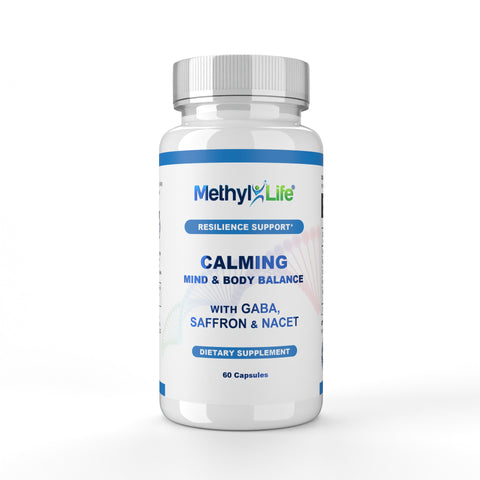
What is GABA and how does it work in the brain?
Product Recommendations
Calming Mind & Body Balance
$49.00
- GABA Provides a Sense of Calm & Helps Manage Cortisol
- GABA Promotes Restful Sleep & Supports Cognitive Function
- 3rd-Party Tested For Purity, Potency & Safety
- 60 Vegan, Non-GMO, Gluten-Free Servings

Written By:
Katie Stone - Naturopath
Medical Reviewer:
Dr. Conor Sheehy - PharmD, BCPS
Edited By:
Kari Asadorian - BSN, RNUpdated On:
January 20, 2025How does GABA work in the brain?
GABA's main role is to reduce brain activity by slowing down the signals between nerves in the brain. When these nerve transmissions are happening very quickly or for a long period of time (referred to as hyperexcitability) you may feel more anxious and overwhelmed1
Effects of surplus GABA
Surplus GABA can lead to sluggishness, foggy thinking, and hypersomnia (excessive sleepiness).
Drugs such as sedatives and anxiolytics are used to increase the amount of GABA, as they slow brain activity and produce a sleepy, relaxed state.2 Benzodiazepine overdose is the result of excess GABA. Many of these drugs have the potential to become addictive, and should only be used under the supervision of a health professional.
In extreme cases, excess GABA can reduce brain activity to the extent of central nervous system depression, which causes breathing rate and heart rate to decrease, potentially leading to loss of consciousness.
Effects of deficit GABA
Anxiety disorders such as panic disorder, post-traumatic stress disorder, and generalized anxiety disorder are associated with decreased levels of GABA. GABA signaling deficits also play a role in depression. Some research has shown that people with major depression have a reduced number of GABAergic neurons.3
Decreased GABA function accompanies both depressed and manic mood states. Low GABA levels are found in the brain, cerebrospinal fluid and plasma of patients with depression and in plasma of patients with mania. GABA agonists can be used as antidepressant and antimanic agents.
Synaptic transmission relies on the balance between calcium and GABA in the brain. Reduced GABA promotes oxidative stress and mitochondrial dysfunction, which is linked with Parkinson’s disease.4
High glutamate levels have been noted in chronic degenerative diseases such as Alzheimer’s disease, and Huntington’s disease. Excess glutamate and deficient GABA can occur due to overexcitation, leading to seizures, epilepsy, spastic disorders, brain injuries, or stroke.5
In serious cases, glutamate-induced excitotoxicity can cause neuronal death throughout the central nervous system.6
GABA and glutamate
GABA and glutamate are the major inhibitory and excitatory neurotransmitters in the brain.
Inhibitory GABA and excitatory glutamate work together to control many processes, including the brain’s overall level of excitation.
Glutamate and GABA have opposing roles. Glutamate excites neurons, allowing chemical messages to be sent between different nerve cells. Think of glutamate as your “get up and go” - like the gas pedal for your brain’s activity. Glutamate causes nerve cells to fire by binding to neuronal receptors, stimulating activity.
We don’t need these receptors firing constantly, so when their work is done, GABA acts as the “chill pill” or the brake pedal on activity. GABA steps in to block transmission to glutamate receptors, preventing further messages from being sent. This helps to reduce excessive brain activity, and leaves you feeling more relaxed and less anxious.
To think and behave normally in everyday life, we need these two neurotransmitters to be in balance. Too much glutamate and not enough GABA can lead to a heightened state of arousal and anxiety, while too much GABA and not enough glutamate can lead to a lethargic, sedated state.
Elevated glutamatergic neurotransmission has been associated with various neurological and psychiatric disorders including autism spectrum disorders and anxiety disorders.7
How to lower glutamate and increase GABA
Lifestyle modifications and various dietary supplements have been shown to restore a healthy balance of glutamate and GABA.
GABA supplements: Although research is limited, GABA supplements may help to increase GABA in the brain. One study found that GABA supplementation helped people feel more relaxed and less anxious when under stressful conditions.8 Consuming GABA-fortified oolong tea was shown to significantly decrease stress levels and improve heart rate variability. 9
Magnesium: As a GABA receptor agonist, magnesium stimulates GABA activity by binding to the GABA receptor and mimicking its actions. Magnesium may help to promote GABA activity by blocking the NMDA receptor, an excitatory receptor that can cause anxiety and restlessness when overactive. Supplementing with magnesium can decrease concentrations of the stress hormone cortisol, which helps to calm the central nervous system.10
Probiotics: Supplementation with bifidobacteria and lactobacilli taken in combination or independently have been shown to act on the gut-brain axis as psychobiotics, reducing both glutamate excitotoxicity and oxidative stress.11
Ashwagandha: Ashwagandha is believed to mimic the effect of GABA, helping to reduce anxiety. Its key constituents are shown to improve GABAergic signaling dysfunction, which can help to relieve general anxiety disorders, sleep disturbances, muscle spasms, and seizures.12
L-theanine, particularly when combined with magnesium, is shown to increase expression of GABAergic, serotonergic, and glutamatergic receptors. This helps to decrease excitatory brain activity and increase slow-brain waves, and increase neurotransmitter and GABA receptor levels.13
Saffron: Safrana, an organic compound isolated from saffron, harbors bioactive constituents that have been shown to relieve disorders of the central nervous system including depression, schizophrenia, memory disorders and anxiety. Saffron acts as an agonist on GABA receptors, increasing GABA activity.14
Psychological stress and/or drinking alcohol to excess may mimic GABA, causing symptoms of depression. Abstaining from these factors can help GABA return to its normal levels.15
GABA and serotonin
Serotonin is another neurotransmitter that plays an important role in mood and anxiety.
Research suggests that serotonin has a complex role in controlling the activity of glutamate and GABA because serotonin interacts with many different types of other serotonin receptors and also influences other brain chemicals, including noradrenaline and dopamine, which act as neuromodulators. Like GABA, irregularities with serotonin have been linked to conditions such as schizophrenia, autism, cognitive and motor issues, migraines, and drug addiction.16
GABA helps control the activity of serotonin in the brain by slowing down the neurons that produce it. When GABA is activated, it raises serotonin levels while reducing how much the brain uses. However, it has also been shown that blocking GABA causes more serotonin to be produced and used. This suggests that GABA acts like a brake on serotonin, helping regulate its production and use in different ways depending on the situation.17
Some earlier research has suggested that GABA plays a dominant role in limiting serotonin levels, while glutamate has a weak stimulating effect on serotonin. Blocking GABA receptors led to a significant rise in serotonin, indicating that GABA has a stronger influence in reducing serotonin release.18
NAC and GABA: Can you take them together?
N-Acetyl Cysteine (NAC) helps to regulate glutamate levels, reducing excess glutamate and replenishing glutathione, the most important antioxidant in the brain. Patients treated with NAC for eight weeks were found to have increased glutathione and decreased glutamate compared with placebo.19
If you are considering taking NAC and GABA together, first speak to your health professional.
What is GABA and how does it work in the brain?
Understanding how GABA works in the brain can provide powerful insights into why you feel anxious or overwhelmed at times.
Product Recommendations
CALMING Your Stress Naturally with the Best GABA Supplement
$49.00
- GABA Provides a Sense of Calm & Helps Manage Cortisol
- GABA Promotes Restful Sleep & Supports Cognitive Function
- 3rd-Party Tested For Purity, Potency & Safety
- 60 Vegan, Non-GMO, Gluten-Free Servings
Frequently Asked Questions about GABA in the brain
Several nutritional and lifestyle factors can cause a lack of GABA in the brain:
Stress:
Studies show that acute psychological stress quickly reduces GABA activity in the brain.20 The exact reasons and effects of this decrease in GABA function, especially in relation to anxiety disorders, is not yet fully understood.
Low B6
Low B6 The enzyme glutamic acid decarboxylase (GAD), which converts glutamate to GABA, must be activated by pyridoxal phosphate. Pyridoxal phosphate is derived from vitamin B6. In the case of B6 deficiency, GABA synthesis diminishes.21
High-fat diet
GABA plays a key role in regulating appetite, food intake, and body weight by controlling neuronal activity in the frontal cortex. Research has shown that a high-fat diet decreases GABA levels in the frontal cortex and hippocampus, which likely disrupts the GABAergic inhibitory processes and may explain feeding behavior.22
Supplements such as magnesium, Ashwagandha, L-theanine, Safrana, and GABA itself may help to increase GABA levels in the brain.
Physical exercise such as yoga can help to increase GABA in the brain. One study found that people who practised yoga every day for 12 weeks experienced increased brain GABA levels, reduced stress, and overall improved mood.23
Another study found that vigorous exercise sessions of 8-20 minutes have also been shown to improve both glutamate and GABA levels.24
However, it is also possible to increase GABA simply by drinking tea every day, especially oolong, green, or white tea. All types of teas contain modest amounts of GABA, but GABA-enriched oolong tea appears to have the highest content.25
GABA is produced from glutamate, an excitatory neurotransmitter, in special inhibitory neurons in the brain called GABAergic neurons. This process is driven by an enzyme called glutamate decarboxylase. When a nerve impulse reaches a GABAergic neuron, it triggers the release of GABA stored in small vesicles within the neuron. GABA is then released into the synaptic cleft (the space between two neurons) where it can act on both the neuron sending the signal (the presynaptic neuron) and the neuron receiving it (the postsynaptic neuron), helping to reduce or inhibit further nerve activity.26
References
-
Jeffrey B Rosen, Jay Schulkin; "Hyperexcitability: From Normal Fear to Pathological Anxiety and Trauma"; Frontiers In Systems Neuroscience; 2022 Aug
https://www.ncbi.nlm.nih.gov/pmc/articles/PMC9387392/
-
Ning Li, Jiale Liu, Mengyang Wang, Zepeng Yu, Kuo Zhu, Jiaqi Gao, Chunmei Wang, Jinghui Sun, Jianguang Chen, He Li; "Sedative and hypnotic effects of Schisandrin B through increasing GABA/Glu ratio and upregulating the expression of GABAA in mice and rats"; Biomedicine & Pharmacotherapy Vol. 103 Pg. 509-516; 2018 Jul
https://www.sciencedirect.com/science/article/abs/pii/S0753332218308564
-
Anthony S. de Leon, Prasanna Tadi; "Biochemistry, Gamma Aminobutyric Acid"; StatPearls [Internet]; 2023 May
https://www.ncbi.nlm.nih.gov/books/NBK551683/#
-
Bandar Alharbi, Hayder M. Al-kuraishy, Ali I. Al-Gareeb, Engy Elekhnawy, Hind Alharbi, Athanasios Alexiou, Marios Papadakis, Gaber El-Saber Batiha; "Role of GABA pathway in motor and non-motor symptoms in Parkinson's disease: a bidirectional circuit"; European Journal of Medical Research; 2024 Mar
https://eurjmedres.biomedcentral.com/articles/10.1186/s40001-024-01779-7
-
Anthony S. de Leon, Prasanna Tadi; "Biochemistry, Gamma Aminobutyric Acid"; StatPearls [Internet]; 2023 May
https://www.ncbi.nlm.nih.gov/books/NBK551683/
-
Christiane S. Hampe, Hiroshi Mitoma, Mario Manto; "GABA and Glutamate: Their Transmitter Role in the CNS and Pancreatic Islets"; GABA And Glutamate - New Developments In Neurotransmission Research, 2017 May
https://www.intechopen.com/chapters/57103
-
Christiane S. Hampe, Hiroshi Mitoma, Mario Manto; "GABA and Glutamate: Their Transmitter Role in the CNS and Pancreatic Islets"; GABA And Glutamate - New Developments In Neurotransmission Research, 2017 May
https://www.intechopen.com/chapters/57103
-
Adham M Abdou, S Higashiguchi, K Horie, Mujo Kim, H Hatta, H Yokogoshi; "Relaxation and immunity enhancement effects of gamma-aminobutyric acid (GABA) administration in humans"; BioFactors (Oxford, England); 2006
https://pubmed.ncbi.nlm.nih.gov/16971751/
-
Tina Hinton Herbert F Jelinek, Vincent Viengkhou, Graham A Johnston, Slade Matthews; "Effect of GABA-Fortified Oolong Tea on Reducing Stress in a University Student Cohort"; Frontiers In Nutrition; 2019 Mar
https://pubmed.ncbi.nlm.nih.gov/30972340/
-
Elmar Wienecke, Claudia Nolden; "Long-term HRV analysis shows stress reduction by magnesium intake"; MMW Fortschritte der Medizin; 2016 Dec
https://pubmed.ncbi.nlm.nih.gov/27933574/
-
Rawan M Bin-Khattaf, Mona A Alonazi, Abeer M Al-Dbass, Ahmad T Almnaizel, Hisham S Aloudah, Dina A Soliman, Afaf K El-Ansary; "Probiotic Ameliorating Effects of Altered GABA/Glutamate Signaling in a Rodent Model of Autism"; Metabolites; 2022 Aug
https://www.ncbi.nlm.nih.gov/pmc/articles/PMC9416367/
-
Manuel Candelario, Erika Cuellar, Jorge Mauricio Reyes-Ruiz, Narek Darabedian, Zhou Feimeng, Ricardo Miledi, Amelia Russo-Neustadt, Agenor Limon; "Direct evidence for GABAergic activity of Withania somnifera on mammalian ionotropic GABAA and GABAρ receptors"; Journal Of Ethnopharmacology; 2015 Aug
https://pubmed.ncbi.nlm.nih.gov/26068424/
-
Muhammed Furkan Dasdelen, Sezgin Er, Berkan Kaplan, Suleyman Celik, Mustafa Caglar Beker, Cemal Orhan, Mehmet Tuzcu, Nurhan Sahin, Havakhanum Mamedova, Sarah Sylla, James Komorowski, Sara Perez Ojalvo, Kazim Sahin, Ertugrul Kilic; "A Novel Theanine Complex, Mg-L-Theanine Improves Sleep Quality via Regulating Brain Electrochemical Activity"; Frontiers In Nutrition; 2022 Apr
https://www.ncbi.nlm.nih.gov/pmc/articles/PMC9017334/
-
Seyyed Kiarash Sadat Rafiei, Setare Abolghasemi, Mahsa Frashidi, Shiva Ebrahimi, Fatemeh Gharei, Zahra Razmkhah, Najmeh Tavousi, Behnaz Mahmoudvand, Melika Faani, Narges Karimi, Amir Abdi, Mahsa Soleimanzadeh, Mahya Ahmadpour Youshanlui, Sayedeh-Fatemeh Sadatmadani, Reyhaneh Alikhani, Yasamin Pishkari, Niloofar Deravi; "Saffron and Sleep Quality: A Systematic Review of Randomized Controlled Trials"; Nutrition And Metabolic Insights; 2023 Jul
https://www.ncbi.nlm.nih.gov/pmc/articles/PMC10357048/
-
F Petty, "GABA and mood disorders: a brief review and hypothesis"; Journal Of Affective Disorders; 1995 Aug
https://pubmed.ncbi.nlm.nih.gov/8550953/
-
L Ciranna, "Serotonin as a Modulator of Glutamate- and GABA-Mediated Neurotransmission: Implications in Physiological Functions and in Pathology", Current Neuropharmacology; 2006 Apr
https://www.ncbi.nlm.nih.gov/pmc/articles/PMC2430669/
-
M. Didier, M.F. Belin, M. Aguera, M. Buda, J.F. Pujol; "Pharmacological effects of GABA on serotonin metabolism in the rat brain"; Neurochemistry International Vol. 7 Iss. 3 Pg 481-489; 1985
https://www.sciencedirect.com/science/article/abs/pii/019701868590172X
-
R Tao, S B Auerbach; "Regulation of serotonin release by GABA and excitatory amino acids"; Journal Of Psychopharmacology (Oxford, England); 2000 Jun
https://pubmed.ncbi.nlm.nih.gov/10890306/
-
Yvonne S. Yang, Richard J. Maddock, Huailin Zhang, Junghee Lee, Gerhard Hellemann, Stephen R. Marder, Michael F. Green; "N-Acetylcysteine effects on glutathione and glutamate in schizophrenia: A preliminary MRS study"; Psychiatry Research: Neuroimaging Vol. 325; 2022 Sept
https://www.sciencedirect.com/science/article/abs/pii/S0925492722000762
-
Gregor Hasler, Jan Willem van der Veen, Christian Grillon, Wayne C Drevets, Jun Shen; "Effect of Acute Psychological Stress on Prefrontal GABA Concentration Determined by Proton Magnetic Resonance Spectroscopy", The American Journal Of Psychiatry; 2011 Jun
https://www.ncbi.nlm.nih.gov/pmc/articles/PMC3107037/
-
Purves D, Augustine GJ, Fitzpatrick D; "GABA and Glycine"; Neuroscience, 2nd edition; 2001
https://www.ncbi.nlm.nih.gov/books/NBK11084
-
Cuauhtemoc Sandoval-Salazar, Joel Ramírez-Emiliano, Aurora Trejo-Bahena, Cecilia I Oviedo-Solís, Martha Silvia Solís-Ortiz; "A high-fat diet decreases GABA concentration in the frontal cortex and hippocampus of rats"; Biology Research; 2016 Feb
https://www.ncbi.nlm.nih.gov/pmc/articles/PMC4772645/
-
Chris C Streeter, Theodore H Whitfield, Liz Owen, Tasha Rein, Surya K Karri, Aleksandra Yakhkind, Ruth Perlmutter, Andrew Prescot, Perry F Renshaw, Domenic A Ciraulo, J Eric Jensen; "Effects of Yoga Versus Walking on Mood, Anxiety, and Brain GABA Levels: A Randomized Controlled MRS Study", Journal Of Alternative And Complementary Medicine; 2010 Nov
https://pmc.ncbi.nlm.nih.gov/articles/PMC3111147/
-
Richard J. Maddock, Gretchen A. Casazza, Dione H. Fernandez, Michael I. Maddock; "Acute Modulation of Cortical Glutamate and GABA Content by Physical Activity"; Journal of Neuroscience; 2016 Feb
https://www.jneurosci.org/content/36/8/2449
-
Tina Hinton, Graham A R Johnston; "GABA-enriched teas as neuro-nutraceuticals"; Neurochemistry International; 2020 Dec
https://pubmed.ncbi.nlm.nih.gov/33144101/
-
The Human Memory, "GABA", https://human-memory.net/, 2022 May
https://human-memory.net/gaba/
-
Banner Image Designed by Freepik
https://www.freepik.com/

About the Author
Katie is a qualified Naturopath (BNatMed) and freelance writer from New Zealand. She specializes in all things health and wellness, particularly dietary supplements and nutrition. Katie is also a dedicated runner and has completed more half-marathons than she can count!
Related Articles

Like what you read?
Please subscribe to get more content like this sent to your inbox.
Share This Article
Trusted by Experts. Backed by Science.
Trusted professionals crafting original content backed by verified research. Since 2012, Methyl-Life® has been dedicated to providing evidence-based education to help individuals better understand methylation and nutritional wellness.
-

Expert-authored education
Every article and guide is written or reviewed by professionals specializing in methylation science and nutritional biochemistry.
-

Research-verified information
Our content references peer-reviewed studies and verified data, ensuring accuracy, integrity, and real-world relevance.
-

Educational leadership since 2012
A founder-led team collaborating with clinicians, researchers, and health writers to make complex science accessible and actionable.
-

Transparent and trustworthy
All educational materials undergo internal review for scientific accuracy, compliance, and clarity before publication.
Blog Categories
Table of Contents
Product Recommendations
CALMING Your Stress Naturally with the Best GABA Supplement
$49.00







